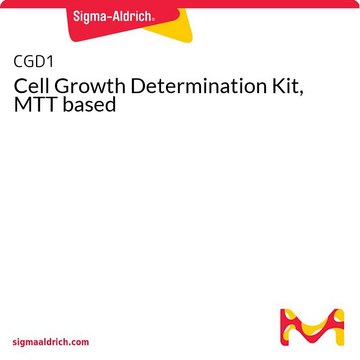1.00326
Hydrogen chloride solution
c(HCl) = 0.1 mol/l (0.1 N) in 2-propanol, DIN ISO 6618, for titration in non-aquous media, Titriplex®
Sinônimo(s):
Hydrogen chloride solution
About This Item
Produtos recomendados
Nome do produto
Hydrogen chloride solution, 0.1M in 2-propanol, acc. to DIN ISO 6618 part 1 c(HCl) = 0.1 mol/l (0,1 N), Titripur®
Nível de qualidade
linha de produto
Titripur®
Formulário
liquid
temperatura de autoignição
425 °C (2-Propanol)
qualidade
Analyzed in our ISO 17025 accredited QC lab
Lim. expl.
2-13.4 % (v/v) 2-Propanol)
adequação da reação
reaction type: Acid-base reactions
concentração
0.1 M
técnica(s)
titration: suitable
pH
<0.5 (20 °C in H2O)
temperatura de transição
flash point 12 °C (2-Propanol)
densidade
0.79 g/cm3 at 20 °C
temperatura de armazenamento
15-25°C
Aplicação
- A highly selective electrochemical sensor for chloramphenicol based on three-dimensional reduced graphene oxide architectures.: This study presents the development of an electrochemical sensor for detecting chloramphenicol in aqueous solutions, leveraging the properties of reduced graphene oxide. Hydrogen chloride solution plays a critical role in the preparation of the graphene oxide, which is instrumental for the sensor′s high sensitivity and selectivity (Zhang et al., 2016).
- Effects of cross-linking molecular weights in a hyaluronic acid-poly(ethylene oxide) hydrogel network on its properties.: This research explores the impact of cross-linking with varying molecular weights on the properties of a hyaluronic acid-polyethylene oxide hydrogel. The use of hydrogen chloride solution in modifying the hydrogel structure is essential for optimizing its physical characteristics for potential analytical chemistry applications (Noh et al., 2006).
- [Determination of docosahexenoic acid in human serum by capillary gas chromatography].: This paper discusses a method for the determination of docosahexenoic acid in human serum using capillary gas chromatography, where hydrogen chloride solution is used during the esterification process of fatty acids, demonstrating its utility in enhancing the precision of analytical techniques (Li et al., 1997, article in Chinese).
Características e benefícios
This volumetric solution is analyzed by our calibration laboratory D-K-15185-01-00 which is accredited according to DIN EN ISO/IEC 17025 for analysis of amount-of-substance concentrations in volumetric solutions by DAkkS (Deutsche Akkreditierungsstelle - German National Accreditation Body). The accreditation certificate can be found at www.sigmaaldrich.com/ISO17025.
Embalagem
Nota de análise
Amount-of-substance concentration 0.0994 - 1.006 mol/L
Measurement uncertainty ± 0.0004 mol/L
Traceability NIST SRM
The concentration is determined by volumetric titration and refers to 20°C.
The amount-of-substance concentration of this volumetric solution is determined with standardized sodium hydroxide solution (article number 1.09141). The sodium hydroxide solution is standardized by hydrogen chloride solution (article number 1.09060) which has been standardized against volumetric standard Tris(hydroxymethyl)aminomethane (article number 1.02408).
This volumetric solution is traceable to a primary standard reference material (SRM) from the National Institute of Standards and Technology, Gaithersburg, USA (NIST SRM 723 Tris(hydroxymethyl)aminomethane) by means of volumetric standard Tris(hydroxymethyl)aminomethane (article number 1.02408), certified reference material according to ISO 17034, analyzed by our accredited calibration laboratory of Merck KGaA, Darmstadt, Germany according to DIN EN ISO/IEC 17025. The uncertainty is expressed as expanded measurement uncertainty with a coverage factor k=2 covering a confidence level of 95%.
Note: The titer is a correction factor to correct for variations of the volumetric solution, the titration equipment, the temperature and other laboratory conditions. For correct titration results it is recommended to determine a titer with the laboratory specific equipment and under laboratory specific conditions directly after opening a new bottle and at regular time intervals.
Informações legais
produto relacionado
Palavra indicadora
Danger
Frases de perigo
Declarações de precaução
Classificações de perigo
Eye Irrit. 2 - Flam. Liq. 2 - Met. Corr. 1 - STOT SE 3
Órgãos-alvo
Central nervous system
Código de classe de armazenamento
3 - Flammable liquids
Classe de risco de água (WGK)
WGK 1
Ponto de fulgor (°F)
53.6 °F - (2-Propanol)
Ponto de fulgor (°C)
12 °C - (2-Propanol)
Certificados de análise (COA)
Busque Certificados de análise (COA) digitando o Número do Lote do produto. Os números de lote e remessa podem ser encontrados no rótulo de um produto após a palavra “Lot” ou “Batch”.
Já possui este produto?
Encontre a documentação dos produtos que você adquiriu recentemente na biblioteca de documentos.
Os clientes também visualizaram
Artigos
SmartChemicals enable wireless transfer of CoA data stored on an RFID tag on the consumable bottle to the titrator, reducing effort and chance for human error. Crucial data required for the application is transmitted safely, reliably and intelligently to the instrument.
Nossa equipe de cientistas tem experiência em todas as áreas de pesquisa, incluindo Life Sciences, ciência de materiais, síntese química, cromatografia, química analítica e muitas outras.
Entre em contato com a assistência técnica






